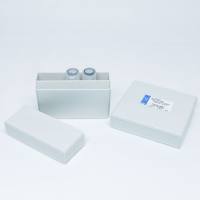Simultaneous, Untargeted Metabolic Profiling of Polar and Nonpolar Metabolites by LC‐Q‐TOF Mass Spectrometry
互联网
- Abstract
- Table of Contents
- Materials
- Figures
- Literature Cited
Abstract
At its most ambitious, untargeted metabolomics aims to characterize and quantify all of the metabolites in a given system. Metabolites are often present at a broad range of concentrations and possess diverse physical properties complicating this task. Performing multiple sample extractions, concentrating sample extracts, and using several separation and detection methods are common strategies to overcome these challenges but require a great amount of resources. This protocol describes the untargeted, metabolic profiling of polar and nonpolar metabolites with a single extraction and using a single analytical platform. Curr. Protoc. Toxicol. 56:4.39.1?4.39.12. © 2013 by John Wiley & Sons, Inc.
Keywords: untargeted metabolomics; LC?MS/MS; hypothesis generation
Table of Contents
- Introduction
- Basic Protocol 1: Metabolite Extraction
- Basic Protocol 2: LC‐MS/MS
- Basic Protocol 3: Metabolite Identification
- Commentary
- Literature Cited
- Figures
Materials
Basic Protocol 1: Metabolite Extraction
Materials
Basic Protocol 2: LC‐MS/MS
Materials
Basic Protocol 3: Metabolite Identification
|
Figures
-
Figure 4.39.1 (Above) Sample total ion chromatogram (TIC) from rat plasma; (Below) normalized extracted ion chromatograms for several polar and nonpolar metabolites. View Image -
Figure 4.39.2 Example of a PCA‐DA (principal component analysis‐discriminant analysis) scores plot. Legend denotes duration of exposure (skeletal muscle cells) to xanthohumol. View Image -
Figure 4.39.3 Example volcano plot of metabolomics dataset to investigate differences in metabolites for 15 versus 90‐minute treatment times. View Image -
Figure 4.39.4 Metabolite matching by MS and MS/MS. View Image -
Figure 4.39.5 Confirmation of experimental isotope ratio to theoretical isotope ratio. View Image -
Figure 4.39.6 Comparison of experimentally identified metabolite against chemical standard by (A ) LC‐MS and (B ) MS/MS. View Image
Videos
Literature Cited
| Literature Cited | |
| Bowen, B.P. and Northen, T.R. 2010. Dealing with the unknown: metabolomics and metabolite atlases. J. Am. Soc. Mass Spectrom. 21:1471‐1476. | |
| Bruce, S.J., Tavazzi, I., Parisod, V., Rezzi, S., Kochhar, S., and Guy, P.A. 2009. Investigation of human blood plasma sample preparation for performing metabolomics using ultrahigh performance liquid chromatography/mass spectrometry. Anal. Chem. 81:3285‐3296. | |
| Dove, A.D., Leisen, J., Zhou, M., Byrne, J.J., Lim‐Hing, K., Webb, H.D., Gelbaum, L., Viant, M.R., Kubanek, J., and Fernandez, F.M. 2012. Biomarkers of whale shark health: A metabolomic approach. PLoS One 7:e49379. | |
| Dudley, E., Yousef, M., Wang, Y., and Griffiths, W.J. 2010. Targeted metabolomics and mass spectrometry. Adv. Prot. Chem. Struct. Biol. 80:45‐83. | |
| El Rammouz, R., Letisse, F., Durand, S., Portais, J.C., Moussa, Z.W., and Fernandez, X. 2010. Analysis of skeletal muscle metabolome: Evaluation of extraction methods for targeted metabolite quantification using liquid chromatography tandem mass spectrometry. Anal. Biochem. 398:169‐177. | |
| Everroad, R.C., Yoshida, S., Tsuboi, Y., Date, Y., Kikuchi, J., and Moriya, S. 2012. Concentration of metabolites from low‐density planktonic communities for environmental metabolomics using nuclear magnetic resonance spectroscopy. J. Vis. Exp. e3163. | |
| Gregory, K.E., Bird, S.S., Gross, V.S., Marur, V.R., Lazarev, A.V., Walker, W.A., and Kristal, B.S. 2012. Method development for fecal lipidomics profiling. Anal. Chem. 85:1114‐1123. | |
| Jensen, O.N. 2006. Interpreting the protein language using proteomics. Nat. Rev. 7:391‐403. | |
| Patti, G.J. 2011. Separation strategies for untargeted metabolomics. J. Sep. Sci. 34:3460‐3469. | |
| Patti, G.J., Tautenhahn, R., Rinehart, D., Cho, K., Shriver, L.P., Manchester, M., Nikolskiy, I., Johnson, C.H., Mahieu, N.G., and Siuzdak, G. 2012a. A view from above: Cloud plots to visualize global metabolomic data. Anal. Chem. 85:798‐804. | |
| Patti, G.J., Yanes, O., Shriver, L.P., Courade, J.P., Tautenhahn, R., Manchester, M., and Siuzdak, G. 2012b. Metabolomics implicates altered sphingolipids in chronic pain of neuropathic origin. Nat. Chem. Biol. 8:232‐234. | |
| Patti, G.J., Yanes, O., and Siuzdak, G. 2012c. Innovation: Metabolomics: The apogee of the omics trilogy. Nat. Rev. Mol. Cell. Biol. 13:263‐269. | |
| Smolinska, A., Blanchet, L., Buydens, L.M., and Wijmenga, S.S. 2012. NMR and pattern recognition methods in metabolomics: from data acquisition to biomarker discovery: A review. Anal. Chim. Acta 750:82‐97. | |
| Suhre, K., Meisinger, C., Doring, A., Altmaier, E., Belcredi, P., Gieger, C., Chang, D., Milburn, M.V., Gall, W.E., Weinberger, K.M., Mewes, H.W., Hrabe de Angelis, M., Wichmann, H.E., Kronenberg, F., Adamski, J., and Illig, T. 2010. Metabolic footprint of diabetes: A multiplatform metabolomics study in an epidemiological setting. PLoS One 5:e13953. | |
| Sumner, S.J., Burgess, J.P., Snyder, R.W., Popp, J.A., and Fennell, T.R. 2010. Metabolomics of urine for the assessment of microvesicular lipid accumulation in the liver following isoniazid exposure. Metabolomics 6:238‐249. | |
| Sun, J., Li, H., and Yuan, Q. 2012. Metabolic regulation of trisporic acid on Blakeslea trispora revealed by a GC‐MS‐based metabolomic approach. PLoS One 7:e46110. | |
| van den Berg, R.A., Hoefsloot, H.C., Westerhuis, J.A., Smilde, A.K., and van der Werf, M.J. 2006. Centering, scaling, and transformations: Improving the biological information content of metabolomics data. BMC Genomics 7:142. | |
| Yanes, O., Tautenhahn, R., Patti, G.J., and Siuzdak, G. 2011. Expanding coverage of the metabolome for global metabolite profiling. Anal. Chem. 83:2152‐2161. |









